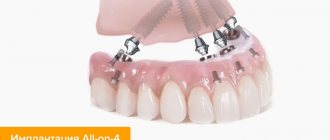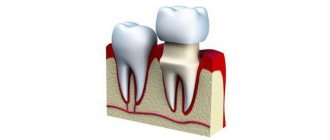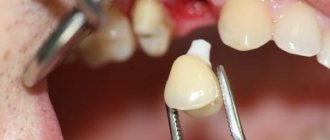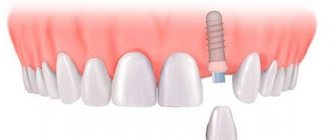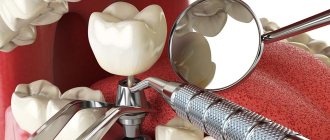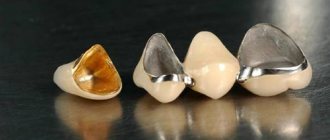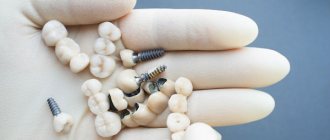Features of the procedure and indications
LeaderStom Clinic offers a wide range of dental services. One of these is prosthetics, which will solve a number of problems:
- save a tooth from destruction while preserving most of the crown;
- restore the integrity of the dentition of the lower or upper jaw;
- eliminate dental defects, even if they are multiple.
Our dental prosthetics clinic offers the safest options for dental treatment and orthopedic services, taking into account the individual characteristics of a particular patient. We take into account all contraindications for prosthetics and offer only the optimal treatment option.
Most often, dentures are recommended for installation when one or more teeth are lost. The absence of at least one tooth reduces chewing function. In the future, the problem leads to atrophic processes, which cause the development of periodontal disease and gastrointestinal diseases.
In addition, prosthetics are recommended in the following cases:
- Increased abrasion of enamel. This problem may have congenital causes or occur against the background of certain diseases. In this case, it is rational to perform prosthetics with veneers in order to prevent irreversible changes in the jaw and reduce the risk of periodontal disease.
- Crown destruction. It can be complete or partial. As a rule, it appears against the background of improper dental care, and after treatment with standard methods it became clear that it was ineffective.
- Adentia, which is the death of the rudiments of teeth or their complete absence. May be a congenital defect or acquired. Installation of a prosthesis is more often recommended, less often an implant.
- Multiple dental defects.
First, the doctor conducts a full examination and prescribes additional tests if necessary. Possible contraindications to prosthetics are identified. Only after this a treatment plan is determined, materials are selected, and the cost of dentures is determined.
Stages of therapy
At the first visit, the patient undergoes a consultation, during which the essence of the technique, its subtleties are explained to him, and he receives all the answers to his questions. The process then takes place in several stages:
- Preliminary examination and examination of the oral cavity. At this stage, X-ray diagnostics are carried out, during which hidden problems are determined, that is, caries and cysts are detected if present. It is possible that wisdom teeth need to be removed, or there is deformation of the jaw bones. This stage is extremely important, since the type of prosthesis and, as a consequence, the final result will depend on the number of supporting teeth.
- The optimal treatment plan is determined and the cost of dental prosthetics is announced. The main thing is that LeaderStom guarantees that the agreed price does not change during the treatment process.
- Sanitation of the oral cavity. This stage should never be skipped. All caries are treated, teeth are cleaned, even the smallest defects that can affect the process of installing dentures are eliminated.
The very last stage is prosthetics. There are several fixation methods: biophysical, biochemical or physical. The choice is based on the data obtained from dental examinations. The correct selection of the fastening method guarantees the durability of the entire system.
Types of fastenings for conditionally removable dentures
A conditionally removable prosthesis
on implants
can be created with various fixators, each of which has its own characteristics and advantages.
Push-button latches
At the beginning of prosthetics, implants are implanted, usually in the upper jaw - 4 rods with a diameter of 4-5 mm, and small ones with a diameter of 1.8-2.3 mm are used in the lower jaw. This makes it possible not to build up bone mass in the jaw and evenly distribute the load on the prosthesis.
After the implants are placed, fixing abutments are installed, which can be of two types:
- Ball-shaped are metal heads in the shape of a ball or a special matrix in the shape of a ring, through which the head easily slides, instantly closing and holding the prosthesis. The disadvantage of this system is that it wears out on average within 3 years, after which it is necessary to replace the spherical abutment with a new one.
- Equatorial ones are more comfortable for patients; the base of the prosthesis contains a silicone matrix and a special holder, which ensures long-term wear without frequent maintenance of the system.
Installation of a prosthesis on implants with fasteners on buttons is carried out quickly, often immediately after implantation of the rods.
Beam clamps
Another method of installing a covering prosthesis is beam fixation. It is a one-piece structure connecting 2-4 implants. For strength, a recess was provided in the base, corresponding in shape to the beam - silicone holders are installed in it. Unlike push-button dentures, bar dentures do not require frequent maintenance and are a more durable product.
More detailed information about different types of prosthetics can be found on the StomInfo portal.
Calculator: calculate prices online
Calculation of the cost of removable dentures
Calculate the cost of removable dentures yourself
Select the type of removable denture
1
Select the number of dentures: 1 or 2
+ The cost of casts is 1200 rubles.
Better and more accurate - in a free consultation! All addresses and telephone numbers are on the website chudostom.ru. Make an appointment by calling the branch closest to you.
The calculation is not a public offer; the final cost is determined at a free consultation BEFORE the start and does not change during the treatment process.
Total cost rub.
0
Types of structures
Dentures can be removable or permanent. The choice is based on the condition of the patient’s teeth, his financial capabilities and medical indications. In our clinic we install both types of prostheses.
Fixed options are designed for long-term use without daily removal. Most often we are talking about crowns, which are made from ceramic mass or metal-ceramics.
Removable systems are held in place by a suction effect and are a viable alternative to implants.
Another option for a removable structure is clasp dentures. The support in this case is the clasp or arc on which the system is held. It is the prices for dental prosthetics in Moscow using this method that are considered the most optimal. But popularity is associated not only with adequate cost, but also with the fact that the clasp prosthesis is physiologically and anatomically ideally matched to the patient, so it is comfortable to wear. Fixation is carried out using attachments or clasps.
Attachments are actually miniature locks mounted in crowns, which are necessarily installed on healthy teeth and provide support. This fastening provides strength to the prostheses and has high aesthetic properties.
Clasps are actually hooks that are attached to the supporting teeth. Thanks to this option, the load on the jaws is distributed as evenly as possible.
Varieties of clasp structures
Among the clasp systems, the following subgroups are distinguished:
- Lamellar. This technology is considered outdated, but is still in demand, since prostheses produced using this method are low in cost. They are made in a short time from medical plastic in standard sizes and in a certain color range. This design allows you to compensate for partial tooth loss or complete edentia.
- Partially removable devices. Well suited for patients who have retained several teeth. However, the main load goes directly to the prosthesis, so it must fit perfectly to the jaw. Fastening is done using hooks. This option is durable and small in size.
- Nylon or silicone. Such prostheses are also called “invisible”. They are truly transparent, do not have clasps, and are practically indistinguishable from natural teeth. And most importantly, they do not cause allergic reactions, the patient gets used to them in just a couple of days. At the same time, they require regular use of Corega cream. They cannot be adjusted after production.
- One-sided.
These are small structures designed to compensate for a small defect on one side of the jaw. Acrylic dentures have been used in dentistry for more than 20 years. In some cases, they are used as a temporary measure until all lost teeth are implanted. Other patients choose the design as a real opportunity to restore the dentition on a permanent basis. Regardless of the final goal, the price of this type of denture is affordable for almost every person. Acrylic dentures can correct the situation with both complete and partial loss of teeth. When completely edentulous, they are installed on pre-installed implants.
Types of fixed structures
The most common fixed dentures are single crowns. But they can be installed provided the root is preserved, that is, they are used to restore the coronal part.
Other types:
- Bridge-like. They are presented in the form of several crowns that are attached to healthy teeth. The design allows you to evenly distribute the load throughout the jaw.
- Dentures on implants, which can be attached to a ball or beam mount.
- Inlays are one of the types of ceramic dentures. Usually used for damaged chewing teeth in order to preserve their hard tissues.
- Veneers. Most often these are ceramic plates that allow you to restore aesthetics. They are mounted on the front surface and can be used to close large gaps between teeth.
The main advantage of fixed structures is quick adaptation to prostheses and high aesthetic qualities due to almost complete invisibility.
Ball-shaped prosthesis on implants
Article navigation
- How are removable dentures on implants different from conventional ones?
- Prosthesis on one-piece mini-implants
- Ball-shaped prosthesis on two-piece classic implants
- Advantages of using ball-shaped dentures on implants
Question for a specialist
Ball-shaped fastening is a locking method of fixing a removable denture on implants, cheaper than a beam design. In the case of spherical attachment, two implantation methods can be used: classic implants with spherical abutments or mini-implants. For fixation, 2 implants are sufficient, but the optimal number is 4-6, since the fewer support points, the more balanced the prosthesis. The second part of the lock is installed inside the prosthesis - a rubber “socket” into which the rounded top of the abutment is placed. This creates a fairly reliable system for attaching implants and prostheses.
A prosthesis that doesn’t fall off = 130,000 rubles. for 1 jaw
Preparation of the oral cavity, implantation of 4 implants with ball-shaped fastening, production and installation of a prosthesis.
Save RUR 20,000. on promotion>> Free consultation with an implantologist +7 (495) 215-52-31 or write to us
Why are removable dentures on implants better than conventional ones?
Removable dentures have a number of disadvantages:
- massive, it takes a long time to get used to them;
- cause discomfort when wearing; dentures completely or partially cover the palate of the upper jaw, thereby affecting the taste buds and can also cause a gag reflex;
- traditional plastic prostheses require special care; moreover, they are fragile and often break;
- long-term wearing leads to bone tissue atrophy, since the entire load from chewing is distributed on the gums. The gums sag, the prosthesis loses its fixation, becomes loose, and may fall out. To solve this problem, patients are forced to resort to relining the prosthesis every 2-3 years.
Even 10 years ago, dentists were working on the technology of additional fastening of removable dentures on the remaining teeth, using additional fixators, for example, clasps or stump inlays with locking fastening. Unfortunately, despite the successes achieved, this approach cannot compare with the effectiveness of implant attachment. Their own teeth fall out or are destroyed due to excessive stress, they have to work, as they say, “for seven.” In addition, your own teeth are susceptible to various diseases, which usually lead to tooth loss; the denture must be changed again. Implants have proven their effectiveness as a reliable support; moreover, they have advanced removable prosthetics to a new level - “conditionally removable prosthetics”. Conditionally removable dentures have eliminated more than half of the disadvantages of removable dentures, such as discomfort, frequency of removal, lack of an artificial palate, loosening and loss.
Is it possible to attach an old removable denture to spherical mini implants?
Many patients are interested in whether it is possible to save the old removable denture and use it for fixation on implants? Experts answer that it is possible, but on the condition that it was initially carried out efficiently and professionally, but no more than 2-3 years ago. However, the existing design cannot be used in its pure form; it will still have to be modified - add an internal fastener for fixation on implants. Fitting a prosthesis can sometimes cost more than creating dentures from scratch. In addition, the new structures will be much smaller in size, since there will be no need to create a massive gum base, which, during conventional fixation, acts as an additional fastener.
Prosthetics with mini-implants: installation stages
- Manufacturing of the prosthesis: impressions are taken in advance, at the manufacturing stage special matrices are fixed in the prosthesis - spherical fasteners into which the spherical tops of the implants will be snapped;
- Installation of implants: mini-implants are thin screws that are fixed by puncturing tissue, due to which the gums and bone are practically not injured, and therefore are restored very quickly. During the operation, normal anesthesia is used;
- Fixation of prostheses: occurs on the same day and immediately after installation of the implants. The spherical top of mini-implants rises above the gum, so the doctor has the opportunity to please the patient with new teeth literally instantly. The denture fits securely to the gum.
The top of the implant has the shape of a ball, and inside the prosthesis the dental technician creates a rounded bed into which the top of the implant is placed when the prosthesis is fixed. After the prosthesis has been installed, the attending physician will definitely instruct you on how to independently remove and return the prosthesis to its place.
Despite the low-traumatic method of fixing mini-implants and all the advantages of rapid dental restoration technology, this method is losing popularity. Mini-implants are very thin; due to excessive loads they often fall out and the entire structure becomes unusable. That is why doctors recommend waiting out the engraftment process and installing classic two-stage implants for conditionally removable prosthetics.
Stages of installing a ball-shaped prosthesis on classic implants:
- implantation;
- installation of abutments with a ball-shaped tip : carried out after complete healing of the implants, on average 4-6 months after surgery;
- taking impressions : in accordance with them, the dental technician will create a prosthesis and fastening inside it;
- fitting of prostheses : if necessary, after fitting, the design is adjusted, because it is important that the prosthesis does not cause discomfort during use;
- fixation of the prosthesis and training the patient in the rules of working with it, including carrying out hygienic procedures.
The spherical design on classic implants can be easily changed, if necessary, to any other one, including replacing removable dentures with permanent ones, without damaging the implants.
Advantages of a ball-shaped prosthesis on implants
- inexpensive installation: such prosthetics will cost several times less than permanent prosthetics on implants;
- easy care;
- quick adaptation - 90% of patients get used to it within 1 week of wearing;
- easy removal of the prosthesis without damaging the implants;
- reliable fixation and comfort: the prosthesis is less massive than a conventional removable one, does not move in the oral cavity, does not cause discomfort and does not require the use of fixing gels;
- the denture does not need to be removed for care after each meal, 2 times daily care in the morning and evening with a toothbrush and taken out for “general cleaning” from time to time is enough, preferably at the dentist;
- no age restrictions;
- easily adjusted if the patient continues to experience some discomfort while wearing;
Compared to fixed bridges on implants, conditionally removable structures are more often subject to repair, since the prostheses must be removed periodically for hygienic procedures, and if this is done very often or carelessly, the manipulation has a very negative impact on the condition of the fastening system on the back side of the prosthesis - unfortunately, , becomes loose and gradually fails.
Important! Despite the fact that the fastening on the prosthesis may deteriorate and become “loose”, this will not in any way affect its support – the implants. It is enough to repair or replace the prosthesis itself.
The load from chewing food with the help of new artificial teeth falls only on the supporting implants - and the bone, free from them, remains little involved in this process. That is why it gradually atrophies (however, much less and more slowly than if conventional removable dentures without implants were installed).
The ball-shaped dentures themselves are very easy to care for: you don’t need to remove them every day, but don’t forget about regular brushing of your teeth in the morning and evening. The use of an irrigator is highly recommended. It is worth removing dentures from the mouth only occasionally for more thorough cleaning, including the tops of the implants. It is best to do this during a routine examination with a dentist.
Author: Vasin Yu. A. (Thank you for your help in writing the article and the information provided)
Crowns with shoulder mass
This method of restoring dentition is one of the most modern. A ceramic mass is laid out along the lower edge of the dental crown. The result is the most comfortable design, to which the patient quickly gets used to. But the most important thing is that the gums do not come into contact with the crowns, as a result of which the gingival area looks aesthetically pleasing.
The main advantages of this technology include:
- high strength indicators;
- no discomfort; long service life;
- the most precise fit;
- no risk of darkening of the gums near the dental neck.
Advantages and disadvantages
Important advantages of fixing a removable denture on ball-shaped abutments are as follows:
- simplified prosthetics;
- budget installation cost. This option of prosthetics is significantly lower in price than other methods of restoring the dentition with implantation;
- no need for daily removal of the prosthesis;
- ease of hygienic care;
- ease of removal of the structure;
- short period of adaptation (about 7 days);
- reliability of fixation;
- no need to use fixing gels;
- There are no age restrictions for installation;
- If the patient begins to experience discomfort while wearing the prosthesis, it can be easily removed from the head to carry out correction.
The disadvantage of ball-shaped fastenings is the uneven distribution of loads on the bone tissue.
In the process of chewing food, those areas where the implants are located are most loaded. All other bone tissue remains unused and atrophies even more over time.
Our branches and price offers
LeaderStom provides prosthetics and dental treatment in 3 branches in Moscow. Each clinic in the network has the most modern equipment and high-quality consumables. But our main pride is our professional doctors.
Remember that even the loss of 1 tooth can lead to disastrous consequences: bone atrophy may begin, the entire row of teeth may shift, roots will be exposed, problems that can only be eliminated through surgery. Therefore, undergo regular oral examinations and contact our clinic in time for professional help.
